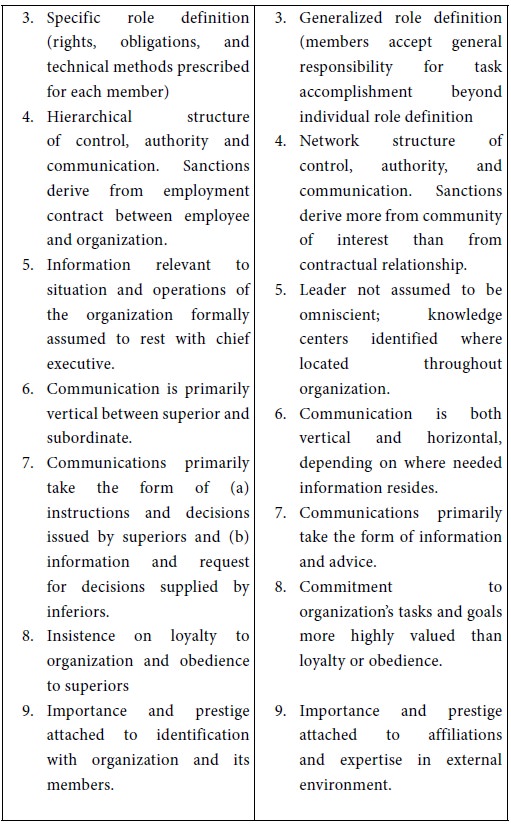Home | ARTS | Management Concepts & Organisational Behaviour
|
Mechanistic Vs. Organic Structures - Emerging Trends In Corporate Structure
Management Concepts & Organisational Behaviour - Emerging Trends In Corporate Structure
Mechanistic Vs. Organic Structures - Emerging Trends In Corporate Structure
Posted On :
Some of the pioneering work on the relationship between organization design and environment was done by Tom Burns and G.M. Stalker.
Mechanistic
Vs. Organic Structures
Some of the pioneering work on the relationship between organization design and environment was done by Tom Burns and G.M. Stalker. They found that successful organizations were designed differently in different environments. They distinguished between two types of organization design: a mechanistic design and an organic design.
A mechanistic Design follows Weber’s bureaucratic model very closely in that it is characterized by specialized activities, specific rules and procedures, an emphasis on formal communication and a well-defined chain of command. Because mechanistic designs tend to be inflexible and resistant to change, this type of design is more successful in a stable environment. The U.S. Army offers a good example of a mechanistic design.
In an organic design, task activities are loosely defined. There are very few rules and procedures, and great emphasis is laid on self-control, participative problem solving and horizontal communication. Organic designs are more successful in dynamic, rapidly changing environments that require adaptability to change. Apple’s early organization design was organic. The personal computer industry (which Apple pioneered) was rapidly changing, and this design was well suited to those early days of a new industry.

Burns and Stalker did not suggest that organizations should essentially adopt any one these two design models. They recognized that the environment surrounding each firm is unique and that each firm must design its structure accordingly. The mechanistic and organic designs are not “either – or” design options; rather, they exist at opposite ends of a continuum along which an organization’s design is characterized.
Later work by Paul Lawrence and Jay Lorsch supported Burns and Stalker’s findings. Lawrence and Lorsch studies several firms in three different industries and found that more effective forms had designs that matched their environments. The effective firms in stable industries had mechanistic organization designs, whereas the most effective firms in turbulent industries had organic designs.
Some of the pioneering work on the relationship between organization design and environment was done by Tom Burns and G.M. Stalker. They found that successful organizations were designed differently in different environments. They distinguished between two types of organization design: a mechanistic design and an organic design.
A mechanistic Design follows Weber’s bureaucratic model very closely in that it is characterized by specialized activities, specific rules and procedures, an emphasis on formal communication and a well-defined chain of command. Because mechanistic designs tend to be inflexible and resistant to change, this type of design is more successful in a stable environment. The U.S. Army offers a good example of a mechanistic design.
In an organic design, task activities are loosely defined. There are very few rules and procedures, and great emphasis is laid on self-control, participative problem solving and horizontal communication. Organic designs are more successful in dynamic, rapidly changing environments that require adaptability to change. Apple’s early organization design was organic. The personal computer industry (which Apple pioneered) was rapidly changing, and this design was well suited to those early days of a new industry.


Burns and Stalker did not suggest that organizations should essentially adopt any one these two design models. They recognized that the environment surrounding each firm is unique and that each firm must design its structure accordingly. The mechanistic and organic designs are not “either – or” design options; rather, they exist at opposite ends of a continuum along which an organization’s design is characterized.
Later work by Paul Lawrence and Jay Lorsch supported Burns and Stalker’s findings. Lawrence and Lorsch studies several firms in three different industries and found that more effective forms had designs that matched their environments. The effective firms in stable industries had mechanistic organization designs, whereas the most effective firms in turbulent industries had organic designs.
Tags : Management Concepts & Organisational Behaviour - Emerging Trends In Corporate Structure
Last 30 days 1277 views












